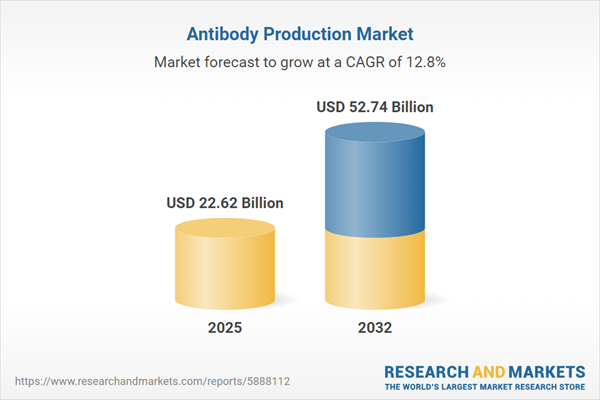Speak directly to the analyst to clarify any post sales queries you may have.
The Antibody Production Market is evolving rapidly, shaped by advanced bioprocess technologies, automation, and strategic collaborations that are redefining workflows and quality standards for therapeutic, diagnostic, and research applications. Senior decision-makers require in-depth, actionable insights to remain competitive and agile across shifting regulatory and economic environments.
Market Snapshot: Antibody Production Market Size & Growth
The Antibody Production Market grew from USD 20.16 billion in 2024 to USD 22.62 billion in 2025. It is expected to continue growing at a CAGR of 12.77%, reaching USD 52.74 billion by 2032. This market expansion is driven by surging biopharmaceutical demand, innovation in production technologies, and increased adoption in emerging therapeutic segments. Organizations across the value chain are implementing continuous manufacturing and digital integration to achieve scalability, operational agility, and enhanced regulatory compliance.
Scope & Segmentation of the Antibody Production Market
This comprehensive research offers detailed segmentation and geographic insights, helping senior leaders identify key opportunities.
- Product: Consumables, Instruments, and Software supporting the full bioproduction process.
- Consumables: Buffers & Reagents, Chromatography Resins, Media essential for reliable process performance.
- Instruments: Bioreactors, Chromatography Systems, Filtration Systems providing scalable and controlled production environments.
- Antibody Type: Monoclonal and Polyclonal antibodies, each requiring unique process strategies.
- Production Process: Downstream and Upstream Processing from cell expansion through purification.
- Class: IgA, IgD, IgE, IgG, and IgM with custom purification and analytics requirements.
- Purification Method: Immobilized Metal Chelate Chromatography, Ion Exchange Chromatography, Size Exclusion Chromatography addressing product specificity.
- Application: Diagnostics, Research, Therapeutics (including Autoimmune Diseases, Cancer Therapy, Infectious Diseases, Neurological Disorders) tailoring workflows and compliance needs.
- End-User: Academic & Research Institutes, Biotechnology Companies, Contract Research Organizations, and Pharmaceutical Companies driving demand and innovation priorities.
- Regional Coverage: Americas (United States, Canada, Latin America), Europe, Middle East & Africa, and Asia-Pacific reflecting diverse infrastructure, regulatory standards, and supply chain strategies.
- Companies Monitored: Leading industry participants include AbbVie Inc., Amgen Inc., AstraZeneca PLC, Biogen Inc., Bristol-Myers Squibb Company, Cell Signaling Technology, Inc., Eppendorf AG, F. Hoffmann-La Roche Ltd., Fibercell Systems Inc, GE HealthCare Technologies Inc., Genmab A/S, GenScript Biotech Corporation, Gilead Sciences, Inc., INTEGRA Biosciences AG, Merck KGaA, Novartis AG, Novo Nordisk A/S, Pall Corporation, Pfizer Inc., ProteoGenix, Sanofi S.A., Sartorius AG, Teva Pharmaceutical Industries Ltd., The Antibody Company, Thermo Fisher Scientific Inc.
Key Takeaways for Senior Decision-Makers
- Automation and digital platforms are improving process consistency and efficiency, enabling workforce redeployment to higher-value activities while ensuring regulatory alignment.
- Adoption of single-use bioreactor systems and modular suites is reducing contamination risk and supporting rapid scale-up, essential for meeting fluctuating demand.
- Integrating analytics-driven process optimization allows early detection of deviations and predictive maintenance, which streamlines campaign timelines and supports operational resilience.
- Sustainable bioprocessing methods, including single-use technologies and continuous manufacturing, are lowering environmental impact while improving resource utilization.
- Strategic sourcing, including supplier diversification and regional partnerships, has become vital for mitigating supply chain vulnerabilities and tariff impacts.
Tariff Impact: Navigating Fiscal and Supply Chain Shifts
Recent United States tariff measures on key raw materials such as chromatography resins and filtration membranes have prompted a reassessment of procurement and vendor relations. These regulatory changes drive companies to explore strategic sourcing and nearshoring options, minimizing exposure and supporting stable cost structures in a volatile trade environment. Collaboration among contract developers and equipment vendors is supporting adaptability and operational stability across global supply chains.
Research Methodology & Data Sources
This report combines structured primary interviews with executives and process experts with a thorough secondary review of peer-reviewed literature, regulatory filings, and market data. Expert validation ensures rigor and reliable, actionable insights tailored to the needs of senior industry leaders.
Why This Report Matters
- Empowers strategic planning through trusted market sizing, segmentation, and technology adoption insights for the antibody production market.
- Supports procurement, risk management, and operational optimization by delivering a clear analysis of regulatory changes, supply chain pressures, and regional differentiation.
- Enables leadership teams to benchmark internal approaches and identify opportunities for collaboration, investment, and technology-driven growth.
Conclusion
The antibody production sector is advancing toward greater automation, sustainability, and supply chain resilience. Aligning operational decisions with these trends prepares organizations to capture growth and maintain compliance in a highly dynamic landscape.
Additional Product Information:
- Purchase of this report includes 1 year online access with quarterly updates.
- This report can be updated on request. Please contact our Customer Experience team using the Ask a Question widget on our website.
Table of Contents
3. Executive Summary
4. Market Overview
7. Cumulative Impact of Artificial Intelligence 2025
Companies Mentioned
The companies profiled in this Antibody Production market report include:- AbbVie Inc.
- Amgen Inc.
- AstraZeneca PLC
- Biogen Inc.
- Bristol-Myers Squibb Company
- Cell Signaling Technology, Inc.
- Eppendorf AG
- F. Hoffmann-La Roche Ltd.
- Fibercell Systems Inc
- GE HealthCare Technologies Inc.
- Genmab A/S
- GenScript Biotech Corporation
- Gilead Sciences, Inc.
- INTEGRA Biosciences AG
- Merck KGaA
- Novartis AG
- Novo Nordisk A/S
- Pall Corporation
- Pfizer Inc.
- ProteoGenix
- Sanofi S.A.
- Sartorius AG
- Teva Pharmaceutical Industries Ltd.
- The Antibody Company
- Thermo Fisher Scientific Inc.
Table Information
| Report Attribute | Details |
|---|---|
| No. of Pages | 198 |
| Published | November 2025 |
| Forecast Period | 2025 - 2032 |
| Estimated Market Value ( USD | $ 22.62 Billion |
| Forecasted Market Value ( USD | $ 52.74 Billion |
| Compound Annual Growth Rate | 12.7% |
| Regions Covered | Global |
| No. of Companies Mentioned | 26 |









